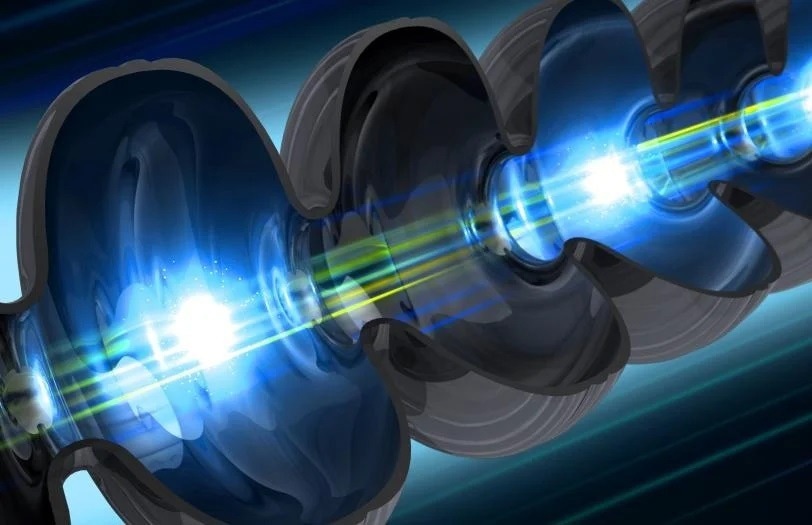Scientists at the SLAC National Accelerator Laboratory of the Department of Energy have expanded the functionalities of the lab’s Linac Coherent Light Source (LCLS) X-Ray free-electron laser (XFEL).

An electron beam travels through a niobium cavity—a key component of SLAC’s LCLS-II X-ray laser. Image Credit: Greg Stewart/SLAC National Accelerator Laboratory
The SLAC team has developed a system capable of producing X-Ray pulses ten times more powerful than before while remaining within the LCLS’s current free-electron laser infrastructure.
This system uses chirped pulse amplification (CPA), a method for creating modern, super-powerful optical laser pulses. The group released their findings on November 18th, 2022 in Physical Review Letters.
Current X-Ray laser pulses from free-electron lasers have a peak power of roughly 100 gigawatts, and usually with a complex and stochastic structure we have shown that we can achieve very impactful beam parameters of greater than 1 terawatt peak power and a pulse duration of about 1 femtosecond at the same time.
Haoyuan Li, Study Lead Author and Postdoctoral Scholar, SLAC National Accelerator Laboratory
Even the Best Laser Has its Limits
Similar to an atomic-resolution camera, LCLS captures images of the smallest changes in molecules and materials in a minuscule fraction of a second.
Its ultrabright, ultrafast X-Ray pulses are of great interest for numerous applications and scientific research in disciplines as varied as the dynamics of biological molecules, laboratory astrophysics, and the study of photon interactions with matter.
The timing of the laser pulses could become erratic with increased laser power, however. The result of this inconsistency is a distorted or inaccurate image of what is happening with the system, which is something scientists are desperately trying to avoid. Existing solutions for that issue drastically cut down on laser power, which restricts what researchers can do.
In the past decade of XFEL laser experiments, more than 90 percent of experiments used the X-Ray source like an ultrafast flashlight. Very few really used it as a ‘laser’ in the sense of how we use optical lasers. We are just starting to learn how to manipulate the X-ray beam like we have done for decades with optical lasers.
Diling Zhu, Study Senior Co-Author and Senior Scientist, SLAC National Accelerator Laboratory
Chirping X-Rays
CPA was initially developed to boost the output of optical lasers, and it works by lengthening the energy pulse’s duration before it passes through an amplifier and a compressor, which reverses the lengthening done in the previous step. A very strong, clear, and brief pulse is the end result.
CPA was created in the 1980s by physicists Donna Strickland and Gérard Mourou from the University of Rochester, who were awarded the 2018 Nobel Prize in Physics for their work. The generation of high-energy pulses for optical lasers has been revolutionized by CPA, but Li said it has been challenging to adapt the method for X-Ray wavelengths.
Li and his colleagues discovered how X-Rays were reflected and dispersed from a crystal in a process known as asymmetric Bragg reflection by designing and putting into practice crystal optics systems for Angstrom wavelengths.
Li added, “We then realized that asymmetric Bragg reflections can be used to implement the CPA mechanism. Then our X-Ray optics team and accelerator physics team worked together to optimize the design based on simulations with realistic beam parameters.”
X-Ray Pulses Within Reach
The researchers created a CPA method for producing high-intensity hard X-Ray pulses within the beam parameters of existing free-electron lasers through meticulous numerical modeling. Other plans for such strong hard X-Ray pulses rely on unrealistic parameters that are unattainable with current technology.
“Our new system shows we can produce terawatt, femtosecond hard X-Ray pulses with existing free-electron laser facilities including LCLS at SLAC,” added Li.
The system must then be built, which will require extensive engineering work.
Li further stated, “We would like to experimentally demonstrate that we can build the required stretcher and compressor that meet the system design specifications, starting with a miniature prototype.”
Zhu stated that the team intends to continue its work.
Zhu added, “Adapting the lessons from many exciting, elegant optical laser technologies to X-Ray wavelengths could lead us to brighter X-Ray laser sources in the future.”
The DOE Office of Science provided funding for the study.
Journal Reference
Li, H., et al. (2022) Femtosecond-Terawatt Hard X-Ray Pulse Generation with Chirped Pulse Amplification on a Free Electron Laser. Physical Review Letters. doi:10.1103/PhysRevLett.129.213901.
Article Revisions
- Mar 11 2025 - Broken links have been fixed.